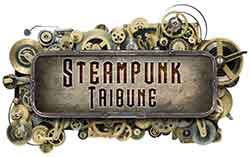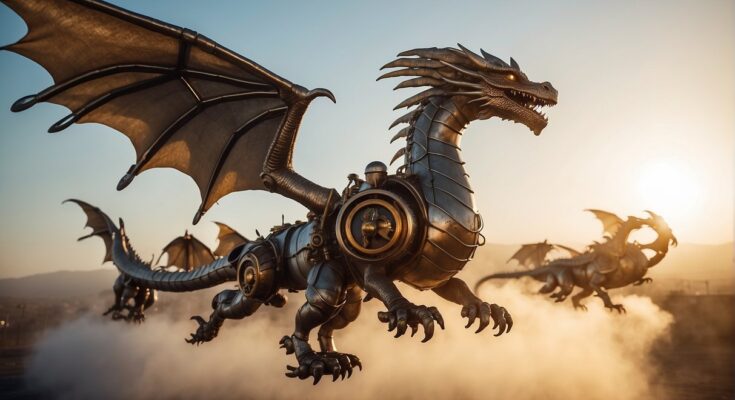Steampunk Dragons blend the aesthetic of 19th-century industrial steam-powered machinery with the mythical grandeur of dragons, creating a subgenre that captivates both fantasy enthusiasts and fans of speculative fiction. This fusion combines the mechanical with the magical, envisioning dragons not merely as creatures of flame and scale but as beings augmented with gears, pistons, and metallic plating. The result is a unique visual and conceptual twist on one of fantasy’s most enduring icons, offering a fresh playground for creativity within the bounds of steampunk’s alternative history.

In literature and art, Steampunk Dragons are often depicted as sentient machines or bio-mechanical entities that inhabit worlds where steam power remains the dominant technology. The concept explores themes of invention and the bounds of nature, asking what it means to be a creature in a world where technology and biology intertwine. These dragons are often symbols of the era’s ingenuity and the human ambition to harness the powers of nature, reflecting steampunk’s larger fascination with innovation and the industrial revolution.
The appeal of Steampunk Dragons is widespread, spanning a variety of media including novels, movies, video games, and tabletop role-playing games. Their presence adds a layer of complexity to the steampunk genre, challenging creators to reimagine the nature of dragons through the lens of Victorian-era technology. As artists and storytellers conjure up these mechanical beasts, they offer audiences a glimpse into alternate realities where the fantastical becomes possible through the gears and steam of human invention.
Origins of Steampunk Dragons
Steampunk dragons merge the mythos of dragons with steampunk aesthetics, drawing from Victorian inspirations and mechanical motifs.
Historical Inspirations
The idea of steampunk dragons takes inspiration from both the historical concept of dragons and the steampunk genre. Dragons have been part of folklore for centuries, embodying power and mystery. Steampunk—a subgenre of science fiction—introduces an alternative 19th-century Victorian era where steam power predominates. This genre often features technology that exaggerates the capabilities of steam-powered machinery, incorporating cogs, gears, and rivets which have become iconic to the aesthetic.
- Victorian Era: The backdrop for steampunk settings, characterized by its industrial advancement and ornate fashion.
- Dragons: Mythical creatures that have undergone various interpretations in different cultures, often depicted as powerful and fearsome.
- Mechanical Elements: Fundamental components like cogs and gears symbolize the industrial touch inherent in steampunk creations.
Dragons in this context are reimagined to fit within a world driven by steam and ironwork, resulting in creatures that mix organic and mechanical elements in their design.
Evolution in Popular Culture
The integration of dragons into the world of steampunk began to take solid shape in popular culture during the late 20th and early 21st centuries. As readers and viewers sought new twists on classic fantasy elements, the fusion of dragons with the industrial-chic of steampunk provided a fresh visual and narrative territory. The resulting creatures often carry an air of nobility and intelligence, paired with the rugged, inventive appeal of steampunk design.
- Literature: Books and graphic novels began to showcase these hybrid creatures, often as intelligent beings with complex societies or as engineered constructs.
- Media: Movies, video games, and art have adopted and expanded upon the concept, each iteration adding more depth to the dragons’ steampunk persona.
This cultural evolution solidifies steampunk dragons not just as a fanciful concept but as an embodiment of ingenuity and the blending of past and futuristic ideas.
Design Elements of Steampunk Dragons

Incorporating the vivid imagination of fantasy with the retro-futuristic aesthetic of steampunk design, steampunk dragons fuse mechanical elements with mythical magnificence. The design intricacies are a testament to creativity and attention to detail.
Aesthetic Characteristics
The steampunk dragon’s appearance often showcases an intricate blend of organic and mechanical features. Scales may intermingle with metal plates, while wings typically combine leather-like membranes stretched over a framework of metal ribs. Visual prominence is given to:
- Exposed Mechanics: Gears and cogs serve as fundamental elements, often seen functioning within wings or along the creature’s body, simulating movement.
- Steam and Pistons: Imagery of steam-powered pistons suggests a dragon’s breath, aligning with the internal fire of traditional dragon lore.
Common Materials and Textures
The tactile quality of a steampunk dragon emphasizes the fusion of resin and metal to create a textured surface that reflects light in ways that mimic the sheen of natural scales. Here are commonly used materials:
- Metals: Brass or bronze surfaces, adorned with rivets and bolts, provide a contrast between the shiny and the matte.
- Resin: This material mimics biological components such as horns or eyes, often tinted or treated to look aged or weathered.
Materials comparison table:
| Material | Use on Dragon | Texture | Note on Aesthetics |
|---|---|---|---|
| Metal | Plating, Framework | Varied | Often aged to enhance steampunk feel |
| Resin | Eyes, Decorative parts | Smooth | Tinted for vintage look |
| Leather | Wings, Saddle | Supple | Works with metal for an industrial mix |
| Gears/Cogs | Functional ornamentation | Metallic | Essential for moving parts illusion |
These elements combined yield a dragon that is not only visually arresting but also resonates with the spirit of an alternative Victorian era—a remarkable icon of steampunk fantasy.
Crafting Steampunk Dragons

Creating a steampunk dragon involves a synthesis of traditional artistic techniques and DIY craft skills. This section aims to guide enthusiasts in hand-painting their own personalized figurines and executing their own steampunk dragon projects.
Hand-Painted Techniques
To hand-paint a steampunk dragon, one must first select an appropriate figurine as a base. Materials often used for these figurines include resin or metal, which should be cleaned and primed before painting. Acrylic paints are recommended due to their versatility and quick drying time. When painting:
- Base Layer: Apply a dark base coat to accentuate the steampunk aesthetic.
- Finer Details: Use fine brushes for intricate gears, cogs, and metallic elements, emphasizing their uniqueness.
To achieve the steampunk look, metallic colors such as bronze, copper, and gold should be used alongside traditional dragon hues. Techniques like dry brushing can highlight textures, creating contrast and depth.
DIY Steampunk Dragon Projects
For those interested in creating their own steampunk dragon from scratch, materials such as polymer clay, metal wire, and various steampunk components like clockwork pieces are essential. The process includes:
- Sculpting: Shape your dragon using polymer clay and wire for the basic structure.
- Assembling: Incorporate gears and metallic pieces into the clay before baking to secure them.
Personalization comes into play when choosing the types of gears and metals, allowing for each piece to carry its maker’s signature style. Safety is paramount; always follow the manufacturer’s instructions when using materials like polymer clay.
Steampunk Dragons in Home Decor
Steampunk dragons have emerged as a distinctive theme in home decor, merging Victorian elegance with mechanical fantasy. They offer a unique aesthetic that can complement various interior design themes, especially for enthusiasts of the steampunk genre.
Wall Clocks and Ornaments
- Wall Clocks: Time-telling becomes an art form with steampunk dragon wall clocks. They often feature intricate gears, metallic finishes, and dragon motifs that seem to guard the passage of time.
- Materials: Predominantly made from metals such as bronze, copper, or brass to reinforce the mechanical aspect.
- Design Detail: Clock hands and roman numerals are common, often accented with small dragon sculptures or embossed images.
- Ornaments: These decorative items can range from small tabletop sculptures to larger wall-mounted pieces.
- Textures and Colors: Emphasize oxidized metals and patinas to give an authentic vintage feel. Colors are typically muted earth tones with occasional jewel-like accents for dragon eyes or scales.
Furniture and Lighting
- Furniture: Furniture pieces can include bookshelves with dragon-shaped supports or coffee tables with mechanical dragons as a base.
- Functionality: While artistic, the functionality remains a priority, ensuring pieces are sturdy and practical.
- Lighting: Lamps and chandeliers often incorporate dragon designs with coiled dragons around the base or stem.
- Ambiance: They provide soft lighting to enhance the mystical atmosphere of the room.
- Finishes: Common finishes include brushed steel or wrought iron to maintain the industrial vibe.
Collecting and Buying Guide
When venturing into the world of Steampunk Dragons, collectors should aim for authenticity and be well-versed in online shopping strategies to secure exclusive pieces.
Identifying Authentic Pieces
Collectors seeking authentic Steampunk Dragon artifacts must pay attention to craftsmanship and provenance. Authentic pieces typically exhibit a high level of detail and are often made from a combination of metals, leather, and gears.
- Materials: True steampunk pieces are crafted from materials such as brass, copper, and leather.
- Craftsmanship: Look for intricate work that includes gears and mechanical elements, a hallmark of the steampunk aesthetic.
- Signatures and Marks: Authentic creations may have the artist’s signature or a unique mark, signifying that the item is not mass-produced.
- Provenance: Documentation or proof of the piece’s history can greatly enhance its authenticity.
Online Shopping Tips
Shopping online for Steampunk Dragons requires knowledge of the marketplace and savvy navigation to ensure a smooth transaction.
- Platform Choices: Websites like Etsy are renowned for unique gift ideas and exclusive Steampunk creations from individual artisans and shops. Platform Features Typical Inventory Etsy Handmade items, vintage goods Exclusive, one-of-a-kind Steampunk Dragons
- Seller Reputation: Evaluate seller ratings and read customer reviews to ensure reliability.
- Payment Security: Ensure the platform offers secure payment options and buyer protection.
- Shipping and Handling: Check shipping policies and costs, as these can vary greatly, especially for international purchases.
By considering these factors, collectors can confidently expand their collection of Steampunk Dragons with unique and authentic pieces.
Commercial Aspect of Steampunk Dragons
The commercial landscape for Steampunk Dragons is a blend of niche market appeal and creative business ventures, characterized by unique options for buyers and opportunities for sellers.
Market Trends and Demand
Steampunk Dragons have carved out a distinctive market segment, melding the aesthetics of Victorian-era steam-powered machinery with mythical creatures. Consumer interest in these fantasy products is fueled by their presence in:
- Literature: A growing number of books and graphic novels feature Steampunk Dragons, bolstering their popularity.
- Art and Sculptures: Limited-edition pieces and commissioned artworks command high prices, showcasing the demand for collectibles.
- Gaming and Role-playing: Tabletop and video games featuring Steampunk Dragons garner a loyal following, translating to sales of related merchandise.
The demand curve for these items tends to follow trends in pop culture and the overall health of the fantasy genre’s market.
Starting a Steampunk Dragon Business
Entrepreneurs looking to start a business in this field should consider the following steps:
- Market Research:
- Analyzing consumer demographics
- Identifying competitors
- Understanding the target audience’s preferences
- Business Planning:
- Crafting a business plan with clear objectives
- Budgeting for initial setup and ongoing operational costs
- Setting prices reflective of the niche market
- Product Development:
- Designing a range of products from affordable trinkets to high-end collectibles
- Ensuring diversity in offerings to cater to different tastes and budgets
- Sales Channels:
- Establishing an online presence with an e-commerce website
- Considering physical storefronts in areas with high foot traffic of fantasy enthusiasts
- Marketing:
- Harnessing the power of social media
- Collaborating with influencers within the Steampunk and fantasy communities
- Attending and vending at relevant conventions and fairs
Focusing on quality and originality will be key for any business venture in this niche market. With the right approach, a Steampunk Dragon business can become both profitable and influential within its community.
Community and Culture
The community surrounding Steampunk Dragons is a fusion of creativity and shared interests in both Victorian-era aesthetics and mythical creatures. Enthusiasts connect through various platforms to share art, ideas, and organize events.
Online Forums and Events
Steampunk Dragons enthusiasts frequent online forums such as The Aether Compactor and Brass Goggles Dragons Den. These forums feature threads dedicated to:
- Crafting tips
- Event announcements
- Art and design sharing
Events range from local gatherings to international conventions, such as CogCon and Dragon Steam Expo. They typically offer workshops, vendor areas, and costume contests. At these events, community members often:
- Showcase their homemade Steampunk Dragon art.
- Participate in panel discussions.
- Engage in role-playing scenarios.
Steampunk and Dragon Enthusiasts
This unique subculture consists of individuals who are passionate about both Steampunk and dragons. They often express their passion through:
- Art: Sculptures, drawings, and digital renderings.
- Costuming: Tailored outfits that blend Victorian fashion with dragon motifs.
- Craftsmanship: Custom-built gadgets and dragon-inspired mechanics.
Enthusiasts also contribute to the culture by writing Steampunk Dragon novellas and developing tabletop games. This creativity fosters a strong sense of community and camaraderie among members.
Marketing Steampunk Dragons
Marketing steampunk dragons involves strategic promotion through various channels to reach enthusiasts and potential customers. A combination of newsletters and social media can significantly boost visibility and engagement.
Using Newsletters for Promotion
Newsletters serve as a direct line of communication with individuals who have shown interest in steampunk dragons. Collecting email addresses through a subscription form on a website allows for regular updates and personalized tips related to steampunk dragons. Each newsletter should contain:
- Exclusive offers: Special discounts or early access to new products for subscribers.
- Personalized content: Updates or articles tailored to the subscriber’s preferences.
Example Newsletter Structure:
1. Introduction: Greeting and brief overview of contents.
2. Highlight of the month: Featured steampunk dragon or related product.
3. Tips or DIY section: How to care for or create steampunk dragon accessories.
4. Subscriber-exclusive offer: Coupon code or early bird special.
5. Conclusion: A thank you note and a teaser for the next issue.
Leveraging Social Media
Social media platforms are invaluable for reaching a broad audience interested in steampunk dragons. Channels like Instagram, Facebook, and Twitter allow for the sharing of images, updates, and promotions. A baseline social media strategy might include:
- Consistent posting: Regular updates to keep the community engaged.
- Hashtag usage: Utilizing popular hashtags to increase visibility.
- Engagement: Interacting with followers through comments, polls, and shares.
| Platform | Post Type | Objective |
|---|---|---|
| Images and Stories | Showcase intricate designs and artwork. | |
| Posts and Live sessions | Announce events and host Q&A sessions. | |
| Tweets and Threads | Share quick updates and engaging with trends |




